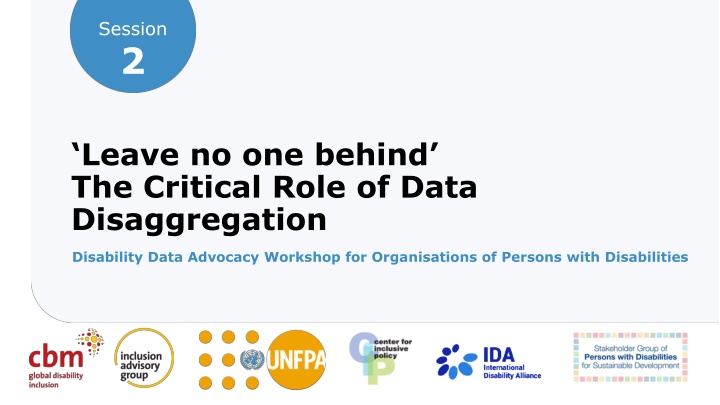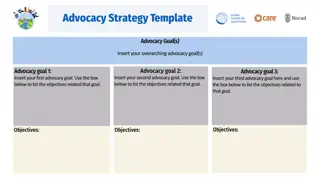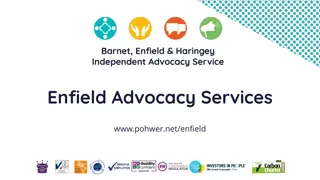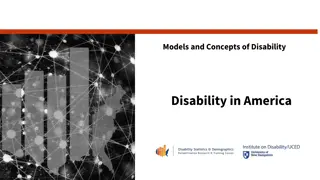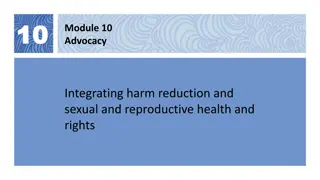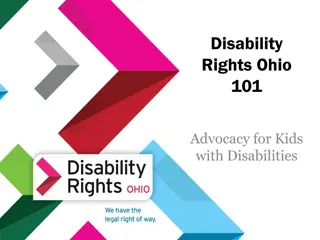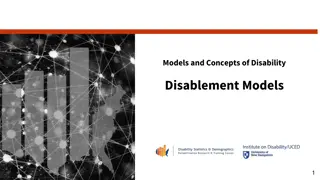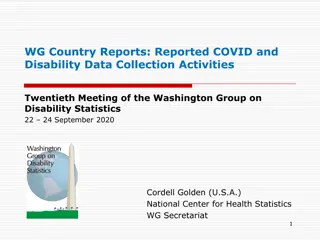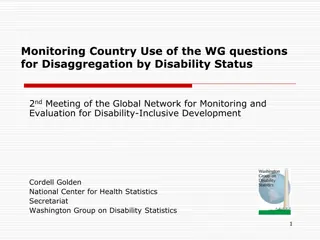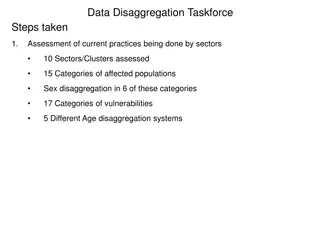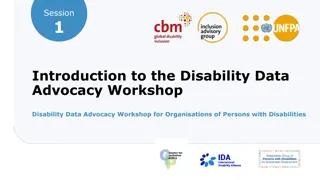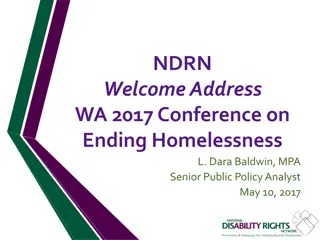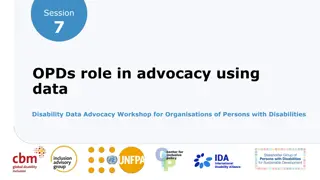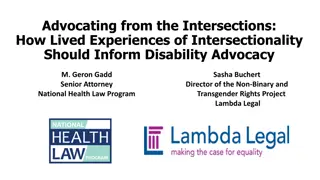The Critical Role of Data Disaggregation in Disability Advocacy
Empower your organization with insights from a workshop on data disaggregation for persons with disabilities. Discover the importance of disaggregated data in measuring equity, inclusion, and advocacy efforts. Learn how to use data to monitor compliance with CRPD and SDG requirements, and leverage disability data for impactful advocacy strategies.
Download Presentation

Please find below an Image/Link to download the presentation.
The content on the website is provided AS IS for your information and personal use only. It may not be sold, licensed, or shared on other websites without obtaining consent from the author.If you encounter any issues during the download, it is possible that the publisher has removed the file from their server.
You are allowed to download the files provided on this website for personal or commercial use, subject to the condition that they are used lawfully. All files are the property of their respective owners.
The content on the website is provided AS IS for your information and personal use only. It may not be sold, licensed, or shared on other websites without obtaining consent from the author.
E N D
Presentation Transcript
Session 2 Leave no one behind The Critical Role of Data Disaggregation Disability Data Advocacy Workshop for Organisations of Persons with Disabilities
Session overview 2 Disability Data Advocacy Workshop for Organisations of Persons with Disabilities SESSION 2
Overview of session What does data disaggregation mean, and what basic data is needed for it? Why is disaggregation is fundamental to measuring equity and inclusion? What is the link between disaggregation and advocacy? How can disaggregation help monitor whether CRPD and SDG requirements have been met? 3 Disability Data Advocacy Workshop for Organisations of Persons with Disabilities SESSION 2
Data disaggregation 4 Disability Data Advocacy Workshop for Organisations of Persons with Disabilities SESSION 2
Useful definitions Indicators: Indicators are used to measure what is happening amongst a population on a certain thing, such as around unemployment. Statistics are used to measure the indicator, e.g., by providing the rate of unemployment. Disaggregated data: Disaggregated data is data that has been broken down by sub- groups, such as by age, ethnicity, or unemployment rate. Disaggregated data can indicate inequalities that may not be fully reflected in aggregated data. Data disaggregated by disability: Data disaggregated by disability refers to describing and comparing the characteristics of persons with disabilities and persons without disabilities to determine if the two groups are similar on the characteristics of interest. For example, employment rates disaggregated by disability compare the employment rate of persons with disabilities to the rate for persons without disabilities to see if the rates are equal. Data is also commonly disaggregated by age, sex, or where people live. Disability identifier: A disability identifier is created from the question(s) in the survey or data collection tool that identifies whether that person has a disability. Note: further useful definitions are provided in the Session 2 handout. 5 Disability Data Advocacy Workshop for Organisations of Persons with Disabilities SESSION 2
Data and the CRPD and the SDGs Both the CRPD and the SDGs: Aim toward the full inclusion for persons with disabilities. Rely on data to assess whether this aim is being achieved. Call for disaggregated data to measure this inclusion. Why is disaggregated data helpful to measure inclusion? Data disaggregated by disability is an important advocacy tool. It identifies: the specific areas where inclusion has not been achieved for persons with disabilities, How much difference between inclusion of persons with and without disabilities 6 Disability Data Advocacy Workshop for Organisations of Persons with Disabilities SESSION 2
An SDG example of disaggregation Advocacy objective: Persons with disabilities should experience the same levels of employment as those without disabilities. CRPD Article 27: Right to work on equal basis with others. SDG: Goal 8.5 regarding full, productive and decent work for all including persons with disabilities. Full employment : Comparing the percentage rate of persons with disabilities and persons without disabilities. Leave no one behind : Persons with disabilities need the same rate of employment as those without disabilities to achieve this goal and advocacy objective. 7 Disability Data Advocacy Workshop for Organisations of Persons with Disabilities SESSION 2
Have we met the CRPD and SDG objectives around full equality and inclusion for persons with disabilities? Proportion employed (%) 90 If bars are equal height, we have achieved the CRPD and SDG objectives. If bars are not at an equal height, further work is required to achieve the CRPD and SDGs. Disaggregated data allows us to split and compare the data into the separate bars for persons with and without disabilities to compare the two. This requires us to be able to identify the persons with disabilities within the total population making up the data. ACTIVITY: Local advocacy objectives 60 30 0 Personswithout disabilities disabilities Personswithout Personswith disabilities disabilities Personswith 8 Disability Data Advocacy Workshop for Organisations of Persons with Disabilities SESSION 2
Data needed to monitor indicators (such as the SDGs) For the SDGs, data is usually obtained from national governments core data systems and targeted surveys e.g., the national census, or population surveys on labour force, living standards, education To assess whether inclusion and equality has been achieved for persons with disabilities in accordance with the CRPD and SDGs, these surveys must: 1. Collect information about the indicator (e.g., rate of employment), and 2. Identify populations with disabilities and without disabilities. The indicator data and the identification of persons with and without disabilities must be obtained from the same data collection system. 9 Disability Data Advocacy Workshop for Organisations of Persons with Disabilities SESSION 2
Defining disability - to identify the population with disabilities we need to define disability The term disability means different things to different individuals and in different contexts. Disability incorporates a range of components, including: Limitations in body functions due to impairments or conditions (e.g., blindness) Limitations in doing core functional domains (e.g., difficulty walking) Restrictions in participation (e.g., exclusion from community events because of inaccessible facilities, transportation, and information) These components are often related and are greatly affected by personal characteristics and the environment: For example, an accommodating environment will reduce barriers and thus increase participation. 10 Disability Data Advocacy Workshop for Organisations of Persons with Disabilities SESSION 2
What is disability? The term disability will mean different things to different individuals both interviewers and respondents involved in data collection surveys,. For data to be reliable, data collection needs to create consistency amongst all people interviewed / data collected. This means that the questions to identify persons with disabilities must be specific in order to capture all persons with disabilities and not risk missing people because they have a different understanding of disability. In some cultures, stigma associated with disability makes people hesitant to openly answer survey questions about disability. This leads to under-identification of persons with disabilities in the population surveyed. 11 Disability Data Advocacy Workshop for Organisations of Persons with Disabilities SESSION 2
Risks of not identifying disability in data Survey questions that are not specific enough about disability can lead to misidentification of persons with disabilities within the data collected. What problems could this lead to? 1. Data that cannot be compared: e.g., Higher representation of disability in data collected from areas that have a broader understanding of what disability involves, and lower representation of disability in data collected from areas that have a narrower understanding. 2. Data that conceals inequality experienced by persons with disabilities: Lower identification of persons with disabilities will mean that persons with disabilities will be included in the persons without disabilities group of data collected on specific indicators (e.g., employment rates). This may hide the additional barriers and inequalities that persons with disabilities are encountering in this area, and incorrectly suggest the indicator or goal is closer to being achieved. 12 Disability Data Advocacy Workshop for Organisations of Persons with Disabilities SESSION 2
Identifying the population with disability using statistical data 13 Disability Data Advocacy Workshop for Organisations of Persons with Disabilities SESSION 2
Identifying the population with disabilities using statistical data (1) The data used to identify the population with disabilities is obtained from questions included in censuses and surveys. It is not possible to write one question or a short set of survey questions that can adequately and accurately capture the complexity of disability in its entirety. And yet, survey questions must be short, clear, and precise. As a result,many problematic questions have been used. Mostly based on the medical model Using the word disability in the question even though there is stigma and different meanings associated with disability. 14 Disability Data Advocacy Workshop for Organisations of Persons with Disabilities SESSION 2
Identifying the population with disabilities using statistical data (2) Given: the complexity of the disability concept, the major differences in how the term is understood within a community or country and across countries, and the stigma attached to the term in some cultures. And that the question Are you disabled? should not be used to identify the population with disabilities for monitoring inclusion. How should the population be defined? 15 Disability Data Advocacy Workshop for Organisations of Persons with Disabilities SESSION 2
Identifying the population with disabilities using statistical data (3) For monitoring inclusion, survey questions to identify the population with disabilities should obtain information on: limitations in functioning, that affect one s ability to participate in society, and if appropriate accommodations are not made. This approach is consistent with the CRPD. 16 Disability Data Advocacy Workshop for Organisations of Persons with Disabilities SESSION 2
Review - Why do we need disaggregated data? When a survey: Identifies the groups with and without disabilities, and Obtains information on the indicators, such as rate of employment (from separate questions but the same data collection tool). Then we can analyse both together. This is called disaggregation, which allows us to: determine whether the CRPD objectives of equality and inclusion have been met. inform national policy and budgeting initiatives. If done over time, monitor whether programs and policies are effectively improving outcomes for persons with disabilities toward equality and inclusion. 17 Disability Data Advocacy Workshop for Organisations of Persons with Disabilities SESSION 2
Potential sources of data to disaggregate SDG 8.5.2 The indicator (8.5.2) is often obtained from: Censuses Labor Force Surveys Other surveys If these sources also obtain questions to identify the population with disabilities: Then SDG 8.5.2 can be disaggregated by disability status. It is then possible to determine whether full inclusion on this indicator has been attained. Proportion employed (%) 90 60 30 0 Personswithout disabilities disabilities Personswithout Personswith disabilities disabilities Personswith 18 Disability Data Advocacy Workshop for Organisations of Persons with Disabilities SESSION 2
Summary of key points Both the CRPD and the SDGs require that data be collected to determine if their objectives around equality and inclusion have been met. Data disaggregation is used for this purpose. Disaggregation requires that the population with disabilities be identified. Given the complexity of the concept of disability, there are different ways to identify the population which will produce different disaggregation. To disaggregate indicators, such as the SDGs, information that identifies the population with disabilities must be included in surveys that collect data. 1.If this is not the case, there is a strong need to advocate for the collection of this data. 2.If it is the case, advocacy can use the results of disaggregation to advocate for policies or programs that will address the inequalities observed. 19 Disability Data Advocacy Workshop for Organisations of Persons with Disabilities SESSION 2
End of session Please complete Individual Reflection Sheets for this session 20 Disability Data Advocacy Workshop for Organisations of Persons with Disabilities SESSION 2
